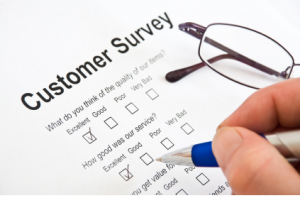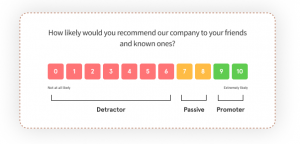In today’s fiercely competitive market, understanding customer needs and preferences is paramount for businesses striving to thrive. Customer surveys stand as indispensable tools for gathering insights into consumer behavior, preferences, and satisfaction levels. This article delves into the world of customer surveys, exploring their types, methods, significance, and examples, providing a holistic understanding of how they drive business success.

What is a Customer Survey?
A customer survey is a structured tool used by businesses to collect feedback from customers regarding their experiences with products, services, or overall interactions with the brand.
It serves as a means to gauge customer satisfaction, identify areas for improvement, and make data-driven decisions to enhance the customer experience. As Bill Gates famously said, “Your most unhappy customers are your greatest source of learning.” Customer surveys enable businesses to tap into this valuable source of learning and turn dissatisfaction into opportunities for growth.
What Are the 4 Types of Customer Satisfaction Surveys?
- Transactional Surveys: These surveys are conducted immediately after a specific customer interaction, such as a purchase or customer service call. They aim to capture the customer’s immediate feedback and satisfaction level with the transaction.
- Relationship Surveys: Relationship surveys focus on the overall satisfaction and loyalty of customers over a more extended period. They provide insights into the customer’s overall perception of the brand and their likelihood to recommend it to others.
- Brand Perception Surveys: Brand perception surveys delve into how customers perceive the brand, its values, reputation, and positioning in the market. They help businesses understand how they are perceived by their target audience and identify areas for brand improvement.
- Net Promoter Score (NPS) Surveys: NPS surveys measure customer loyalty by asking a single question: “How likely are you to recommend our product/service to a friend or colleague?” Respondents are categorized as Promoters, Passives, or Detractors, providing a simple yet powerful metric for gauging customer loyalty and advocacy.

What Are the Methods of Consumer Survey?
- Online Surveys: Online surveys are one of the most common methods of conducting consumer surveys due to their cost-effectiveness, reach, and ease of data collection. Platforms like SurveyMonkey and Google Forms facilitate the creation and distribution of online surveys.
- Phone Surveys: Phone surveys involve contacting customers via phone calls to gather feedback sentiments. While they offer a more personal touch, they can be time-consuming and may yield lower response rates compared to online surveys.
- In-Person Surveys: In-person surveys are conducted face-to-face with customers, often in retail stores, events, or public places. They allow for deeper engagement and more nuanced feedback but require significant resources and planning.
- Mail Surveys: Mail surveys involve sending paper questionnaires to customers via postal mail. While they offer a tangible format for feedback, they are slower and less cost-effective than online surveys.
What Are the Different Types of CX?
Customer Experience (CX) encompasses every interaction a customer has with a brand, from initial awareness to post-purchase support. Different types of CX include:
- Digital Experience: The online experience customers have while interacting with a brand’s website, app, or social media platforms.
- Physical Experience: The in-person experience customers have at brick-and-mortar stores, events, or other physical touchpoints.
- Emotional Experience: The emotional connection customers form with a brand based on how they feel throughout their interactions, including empathy, trust, and satisfaction.
- Omnichannel Experience: The seamless integration of various channels (e.g., online, offline, mobile) to provide a unified and consistent customer experience across touchpoints.
Customer Surveys Examples:
- Starbucks uses transactional surveys to gather feedback on customer satisfaction after each purchase, helping them identify store performance and service issues in real-time.
- Amazon employs relationship surveys to measure customer loyalty and satisfaction over time, leveraging insights to continuously enhance the online shopping experience.
- Apple conducts brand perception surveys to understand how consumers perceive its products, design, and innovation, guiding future product development and marketing strategies.

Customer Survey Questions:
- How satisfied are you with your recent purchase/service experience?
- What factors influenced your decision to choose our brand over competitors?
- How likely are you to recommend our product/service to others?
- What improvements would you like to see in our products/services?
- How can we better meet your needs and expectations in the future?
Importance of Customer Survey:
Customer surveys play a pivotal role in driving business success by:
- Providing valuable insights into customer preferences, behaviors, and satisfaction levels.
- Identifying areas for improvement and innovation to enhance the customer experience.
- Building customer loyalty and advocacy through personalized interactions and responsive service.
- Empowering businesses to make data-driven decisions that align with customer needs and expectations.

NPS Survey:
The Net Promoter Score (NPS) is a widely used metric for measuring customer loyalty and advocacy.
As Fred Reichheld, the creator of NPS, stated, “The only path to profitable growth may lie in a company’s ability to get its loyal customers to become its net promoters—customers who actively recommend the company to others.” By calculating the percentage of Promoters minus the percentage of Detractors, businesses can gauge their NPS and prioritize efforts to turn satisfied customers into loyal brand advocates.
Conclusion: Customer surveys serve as invaluable tools for businesses seeking to understand, measure, and improve the customer experience. By leveraging different survey types, methods, and metrics like NPS, businesses can gain actionable insights, foster customer loyalty, and drive sustainable growth in today’s competitive landscape. As Peter Drucker famously said, “The purpose of business is to create and keep a customer.” Customer surveys enable businesses to fulfill this purpose by putting the customer at the center of their decision-making processes.